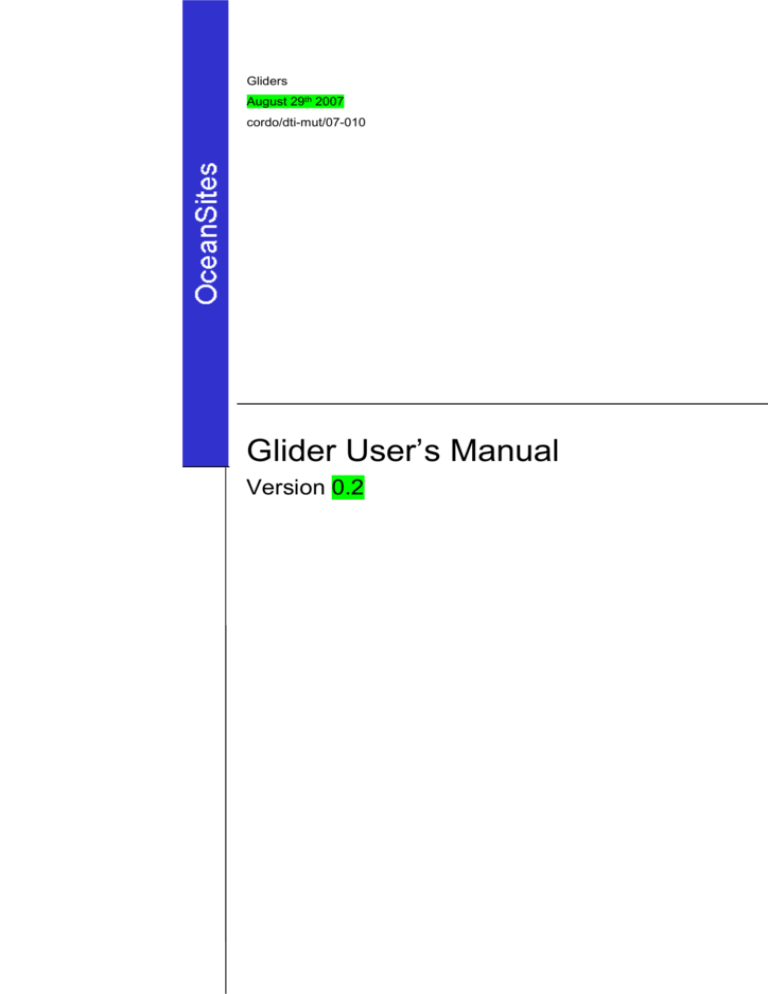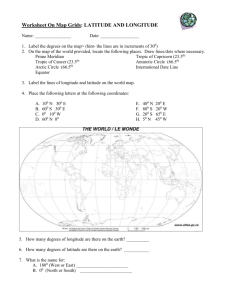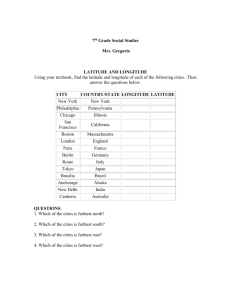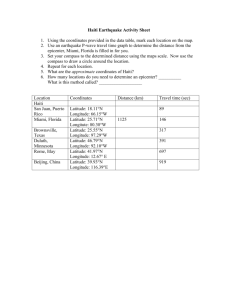Proposal for glider data format - CSIRO Marine and Atmospheric
advertisement

Gliders August 29th 2007 cordo/dti-mut/07-010 Glider User’s Manual Version 0.2 Gliders User’s Manual Ref : cordo/dti-mut/07-010 Version : 2 Date : 29/08/2007 Authors : T. Carval, … 3 Table of contents HISTORY 4 1. OVERVIEW 5 2. GLIDER DATA AND META-DATA FORMAT 6 2.1. DATA FILE DIMENSIONS 2.2. GLOBAL ATTRIBUTES 2.3. MEASUREMENTS 6 7 11 3. REFERENCE TABLES 13 3.1. REFERENCE TABLE 1 : DATA TYPE AND DATA CODE 3.1.1. DATA TYPE 3.1.2. DATA CODE 3.2. REFERENCE TABLE 2 : QUALITY CONTROL FLAG SCALE 3.2.1. REFERENCE TABLE 2.1: QUALITY CONTROL LEVEL INDICATOR 3.3. REFERENCE TABLE 3 : GLIDERS PARAMETER DICTIONARY 3.4. REFERENCE TABLE 4: DATA ASSEMBLY CENTER CODES 13 13 13 13 14 15 17 4. FILE NAMING CONVENTION 18 4.1. DATA FILE NAMING CONVENTION 18 OceanSITES User Manual 17/02/2016 4 History Version 0.1 0.2 Date 12/01/2007 29/08/2007 OceanSITES User Manual Comment TC : creation of the document TC : addition of a latitude_bottom, longitude_bottom for each profile 17/02/2016 5 1. Overview The objective is to define a Glider's file format for data and meta-data. The format definition is derived from Argo NetCDF and OceanSites formats. OceanSITES User Manual 17/02/2016 6 2. Glider data and meta-data format A Glider format file contains the available meta-data and data for one deployment of one glider. The observation data can be stored: o As multiple vertical profiles o As a time-serie (continuous observations recorded during the deployement) Meta-data are stored as global attributes. Data are stored as NetCDF variables. The requirements are drawn from the netCDF Style Guide : Units are compliant with CF/COARDS/Udunits ; Time is encoded as recommended by Unidata and used by COARDS, CF and others. For more information on CF and COARDS see http://www.cgd.ucar.edu/cms/eaton/cfmetadata/CF-1.0.html and http://www.ferret.noaa.gov/noaa_coop/coop_cdf_profile.html. 2.1. Data file dimensions Name TIME Definition TIME= <int value>; LEVEL LEVEL=<int value>; PROFILE PROFILE=<int value> STRING256 STRING64 STRING32 STRING14 STRING8 STRING4 STRING64 STRING64 STRING32 STRING14 STRING8 STRING4 OceanSITES User Manual = 256; = 64; = 32; = 14; = 8; = 4; Comment Number of profiles for vertical profiles. Number of observations for a time serie. Maximum number of levels contained in a profile. Set to 1 for a time serie Example: LEVEL = 100 Number of profiles contained in the file. Set to 1 for a time serie. A file contains at least one profile. Example: PROFILE = 100 String dimensions. 17/02/2016 7 2.2. Global attributes The global attributes follows the recommendations of Unidata NetCDF Attribute Convention for Dataset Discovery : http://www.unidata.ucar.edu/software/netcdfjava/formats/DataDiscoveryAttConvention.html#cdm_data_type_Attribute Nom WHAT title conventions netcdf_version creation_date references provider history summary id naming_authority keywords_vocabulary Valeur Définition file description :title="Mersea Maya The "title" attribute gives a brief description of the dataset. It should be Glider data"; human readable and reasonable to display in a list of such names. e.g. : “Mersea Maya glider data” :conventions="CFName of the conventions followed by the dataset. 1.0"; e.g. : "CF-1.0" :netcdf_version=3.5 Netcdf version used for the data set :creation_date="200 File creation date (UT) 6-04-11 08:35:00 in the form UT"; “yyyy-mm-dd hh:mm:ss UT” (Year-Month-Day-Hour-Minute-second) :references="http:// References that describe the data or the methods used to produce it. Include www.mersea.eu.org here the names of configuration files that have been used as well as selected "; configuration parameters :provider="Ifremer"; Data provider name :history="20050411 The "history" attribute provides an audit trail for modifications to the original 08:35:00 data data. It should contain a separate line for each modification with each line collected"; including a timestamp, user name, modification name, and modification arguments. :summary="…"; The "summary" attribute gives a longer description of the dataset. Its use is highly recommended. In many discovery systems, the title and the summary will be displayed in the results list from a search. It should therefore capture the essence of the dataset it describes. For instance, we recommend this field include information on the type of data contained in the dataset, how the data was created (e.g., instrument X; or model X, run Y), the creator of the dataset, the project for which the data was created, the geospatial coverage of the data, and the temporal coverage of the data. This should just be a summary of this information, more detail should be provided in the recommended creator attributes, the recommended geospatial attributes, and the recommended temporal attributes. :naming_authority=" The "id" and "naming_authority" attributes are intended to provide a globally Ifremer" unique identification for each dataset. The "id" value should attempt to :id=”” CO_GLuniquely identify the dataset. The naming authority allows a further 1_200502_TS » refinement of the "id". The combination of the two should be globally unique for all time. We recommend using reverse-DNS naming for the naming authority. For example, naming_authority="edu.ucar.unidata" and id="NCEP/NAM_211_2005-05-24_12Z". : The "keywords_vocabulary" attribute identifies the controlled list of keywords keywords_vocabular from which the values in the "keywords" attribute are taken. If you are y="…" following a guideline for the words/phrases in your "keywords" attribute, put the name of that guideline here. The use of this attribute is recommended and its value will be used by THREDDS to identify the vocabulary from which the keywords come. Common values for the "keywords_vocabulary" attribute include: Vocabulary ID Reference URL "AGU Index Terms" http://www.agu.org/pubs/indexterms/ "GCMD Science Keywords" http://gcmd.gsfc.nasa.gov/Resources/valids/gc md_parameters.html cdm_data_type comment : cdm_data_type="Ti me-series" :comment="…" data_mode :data_mode="D" OceanSITES User Manual The "cdm_data_type" attribute gives the THREDDS data type appropriate for this dataset. E.g., "Grid", "Image", "Station", "Trajectory", "Radial". The "comment" attribute allows for miscellaneous information about the dataset. Use of this attribute is recommended as appropriate. Indicates if the file contains real time or delayed mode data. R : real time data 17/02/2016 8 WHAT project_name pi_name WHAT platform_code wmo_platform_code ptt trans_system positioning_system D : delayed mode data M : mixed real-time and delayed mode data project description Name of the project that operates the glider. : project_name=”MER Example: MERSEA SEA" :pi_name="Scott Name of the principal investigator in charge of the glider. OLSEN" Example : Scott OLSEN instrument description :platform_code="MA Platform unique code within OceanSITES project. YA" Examples: CIS-1 glider on CIS site (Central Irminger Sea). PIRATA-LAMBADA for Lambada buoy from PIRATA project. :wmo_platform_cod WMO identifier for a glider. e="69047" WMO is the World Meteorological Organization. This platform number is unique within OceanSITES project. Example: 13009 for PIRATA-LAMBADA buoy. :ptt="22507" Transmission identifier of the glider. Example : 22507 : the glider is equipped with one ARGOS beacon. :trans_system="IRI Name of the telecommunication system from reference table 10. DIUM" Example : IRIDIUM :positioning_system Position system from reference table 9. ="GPS" ARGOS or GPS are 2 positioning systems. Example : ARGOS platform_model :platform_model=" WEBB SLOCUM " platform_maker :platform_maker=" Webb Research Corporation " :inst_reference=" SLOCUM-SBE 259" :direction="A" inst_reference direction anomaly WHAT launch_date launch_latitude launch_longitude launch_qc start_date start_date_qc deploy_platform deploy_mission deploy_available_profile_i d end_mission_date OceanSITES User Manual Model of the glider. Example : WEBB SLOCUM Name of the manufacturer. Example : Webb Research Corporation References of the instrument : brand, type, serial number Example : SLOCUM-SBE 259 Direction of the profiles of the glider. A : ascending profiles only D : descending profiles only B : descending and ascending profiles S : time series :anomaly="" This field describes any anomaly or problem the glider may have had. Example : “the immersion drift is not stable.” glider deployment and mission information :launch_date="2006 Date and time (UTC) of launch of the glider. -12-30 09:05:00 UT" Format : yyyy-mm-dd hh:mm:ss UT Example : 2006-12-30 09:05:00 UT :launch_latitude="4 Latitude of the launch. 4.4991" Unit : degree north Example : 44.4991 : 44° 29’ 56.76’’ N :launch_longitude=" Longitude of the launch. 16.7222" Unit : degree east Example : 16.7222 : 16° 43’ 19.92’’ E :launch_qc="1" Quality flag on launch date, time and location. The flag scale is described in the reference table 2. Example : 1 : launch location seems correct. :start_date="2006Date and time (UTC) of the first descent of the glider. 12-30 09:05:00" Format : yyyy-mm-dd hh:mm:ss UT Example : 2006-12-30 09:05:00 :start_date_qc="1" Quality flag on start date. The flag scale is described in the reference table 2. Example : 1 : start date seems correct. :deploy_platform=": Identifier of the deployment platform. L’ATALANTE" Example : L’ATALANTE :deploy_mission=" Identifier of the mission used to deploy the platform. OVIDE 2006" Example : OVIDE 2006 :deploy_available_pr Identifier of CTD or XBT stations used to verify the first profile. ofile_id="58776, Example : 58776, 58777 58777" :end_mission_date= Date (UTC) of the end of mission of the glider. "2007-01-30 Format : yyyy-mm-dd hh:mm:ss UT 09:05:00" Example : 2007-01-30 09:05:00 17/02/2016 9 end_mission_status WHAT sensor1 sensor_maker1 sensor_model1 sensor_serial_no1 sensor_units1 sensor_accuracy1 sensor_resolution1 WHAT parameter1 predeployment_calib_equ ation1 predeployment_calib_coef ficient1 predeployment_calib_com ment1 WHERE area southernmost_latitude northernmost_latitude westernmost_longitude easternmost_longitude minimum_depth maximum_depth WHEN start_date stop_date WHO institution institution_references OceanSITES User Manual :end_mission_status ="RECOVERED" Status of the end of mission of the glider. glider sensors Parameters measured by the sensor1 of the glider. Additionnal sensors are named sensor2…sensorN. The parameter names are listed in reference table 3. Examples : TEMP, PSAL, CNDC TEMP : temperature in celsius PSAL : practical salinity in psu CNDC : conductvity in mhos/m sensor_maker1 Name of the manufacturer of the sensor1. Example : SEABIRD sensor_model1 Model of sensor1. Example : SBE41 sensor_serial_no1 Serial number of the sensor1. Example : 2646 036 073 sensor_units1 Units of accuracy of the sensor1. Example : psu sensor_accuracy1 Accuracy of the sensor1. Example : 0.005 sensor_resolution1 Resolution of the sensor1. Example : 0.001 glider parameter calibrations parameter1 Parameters measured on this float. Additionnal parameters are named parameter2…parameterN. The parameter names are listed inreference table 3. Examples : TEMP, PSAL, CNDC TEMP : temperature in celsius PSAL : practical salinity in psu CNDC : conductvity in mhos/m predeployment_calib Calibration equation for this parameter 1. _equation1 Example : Tc = a1 * T + a0 sensor1 predeployment_calib Calibration coefficients for this equation. _coefficient1 Example : a1=0.99997 , a0=0.0021 predeployment_calib Comments applying to this parameter calibration. _comment1 Example : The sensor is not stable :area="Western Europe"; :southernmost_latitu de="35"; :northernmost_latitu de="55"; :westernmost_longit ude="-11°"; :easternmost longitude="14°"; : minimum_depth ="10.0"; : maximum_depth ="2000.0"; Geographical coverage e.g.: Global Ocean, North Atlantic Ocean, North-West European shelves Value between -90° and 90° Value between -90° and 90° Value between -180° and 180° Value between -180° and 180° Minimum depth for measurements Maximum depth for measurements :start_date="2006Start date of the data in UT 03-01 00:00:00 UT"; in the form “yyyy-mm-dd hh:mm:ss UT” (Year-Month-Day Hour-Minute-second) :stop_date="2006Final date of the data in UT 03-05 23:59:29"; in the form “yyyy-mm-dd hh:mm:ss UT” (Year-Month-Day Hour-Minute-second) :institution="Southa mpton National Oceanographic Centre"; :institution_referenc es=http://www.nocs. uk; Data provider name References for data provider, the place to find all information upon the data set (Web-based) 17/02/2016 10 contact HOW distribution_statement quality_index OceanSITES User Manual :contact=codac@no cs.uk; User desk e-mail :distribution_statem ent=" Data restrictions: for registered users only "; :quality_index="A"; Text like “Approved for public release. Distribution unlimited” or "Data restrictions: for registered users only" or better to link to the place where the rule is described A code value valid for the whole dataset : 0 unknown quality A excellent (no known problems, regular quality checking) B probably good (occasional problems, validation phase) C extremely suspect, frequent problems 17/02/2016 11 2.3. Measurements This section contains measurements performed by the glider during a deployment. The observation data can be stored: As multiple vertical profiles. In that case: o PROFILE dimension is the number of profiles. o TIME dimension is equal to PROFILE (one time per profile) The time is the surface time1 (or closest to surface time) o LEVEL dimension is the maximum number of levels in a profile. o The direction global attribute is set to A, D or B (ascending profiles, descending profiles, or both ascending and descending) As a time-serie. In that case: o PROFILE dimension is set to 1 (the whole deployment is described in a profile) o TIME is equal to the number of observations o LEVEL is set to 1 o An observation is a series of parameters observed at one time. Eg: depth, temperature, salinity, chlorophyle recorded at the same time. o The direction global attribute is set to "S" (time serie) Name TIME LATITUDE LONGITUDE 1 Definition Double TIME(PROFILE,TIME); TIME:long_name = " days since 1950-01-01 00:00:00 UTC"; TIME:standard_name = "time"; TIME:units = "days since 1950-01-01 00:00:00 UTC"; TIME:conventions = "Relative julian days with decimal part (as parts of the day)"; TIME:axis = "T"; TIME:_FillValue = 999999.; TIME:epic_code = 601.; Float LATITUDE(PROFILE,TIME); LATITUDE:long_name = "Latitude of each location"; LATITUDE:standard_name = "latitude"; LATITUDE:units = "degree_north"; LATITUDE:_FillValue = 99999.f; LATITUDE:valid_min = -90.f; LATITUDE:valid_max = 90.f; LATITUDE:epic_code = 500; LATITUDE:axis=’Y’; Float LONGITUDE(PROFILE,TIME); LONGITUDE:long_name = "Longitude of each location"; LONGITUDE:standard_name = "longitude"; LONGITUDE:units = "degree_east"; LONGITUDE:_FillValue = 99999.f; LONGITUDE:valid_min = -180.f; LONGITUDE:valid_max = 180.f; LONGITUDE:epic_code = 501; LONGITUDE:axis=’X’; Comment Julian day of the measurement. The integer part represents the day, the decimal part represents the time of the measurement. Date and time are in universal time coordinate. Example : 18833.8013889885 : July 25 2001 19:14:00 Latitude of the observation (top of the profile). Unit : degree north Example : 44.4991 for 44° 29’ 56.76’’ N Longitude of the observation (top of the profile).. Unit : degree east Example : 16.7222 for 16° 43’ 19.92’’ E This convention is also used for argo profiles, the time of a profile is always the surface time OceanSITES User Manual 17/02/2016 12 LATITUDE_BOTTOM Float LATITUDE_BOTTOM(PROFILE,TIME); LATITUDE_BOTTOM:long_name = "Latitude of profile bottom"; LATITUDE_BOTTOM:standard_name = "latitude"; LATITUDE_BOTTOM:units = "degree_north"; LATITUDE_BOTTOM:_FillValue = 99999.f; LATITUDE_BOTTOM:valid_min = -90.f; LATITUDE_BOTTOM:valid_max = 90.f; LATITUDE_BOTTOM:epic_code = 500; LATITUDE:axis=’Y’; LONGITUDE_BOTTOM Float LONGITUDE_BOTTOM(PROFILE,TIME); LONGITUDE_BOTTOM:long_name = "Longitude of profile bottom"; LONGITUDE_BOTTOM:standard_name = "longitude"; LONGITUDE_BOTTOM:units = "degree_east"; LONGITUDE_BOTTOM:_FillValue = 99999.f; LONGITUDE_BOTTOM:valid_min = -180.f; LONGITUDE_BOTTOM:valid_max = 180.f; LONGITUDE_BOTTOM:epic_code = 501; LONGITUDE_BOTTOM:axis=’X’; <PARAM> Float <PARAM>(PROFILE,TIME, LEVEL); <PARAM>:long_name = "<Y>"; <PARAM>:standard_name = "<X>"; <PARAM>:units = "<Y>"; <PARAM>:_FillValue = <Y>; <PARAM>:QC_indicator = <Z>; <PARAM>:valid_min = <Y>; <PARAM>:valid_max = <Y>; <PARAM>:comment = "<Y>"; <PARAM>:ancillary_variables = "<Y>" ; <PARAM>:resolution = <Y>; <PARAM>:epic_code = <Y>; <PARAM>_QC Byte <PARAM>_QC(PROFILE,TIME, LEVEL); <PARAM>_QC:long_name = “quality flag”; <PARAM>_QC:conventions = “OceanSITES reference table 2”; <PARAM>_QC:_FillValue = 0; <PARAM>_DATA_MODE Char <PARAM>_DATA_MODE(PROFILE,TIME, LEVEL); optional <PARAM>_DATA_MODE:long_name = "Delayed mode or real time data"; <PARAM>_DATA_MODE:conventions = "R : real time; D : delayed mode"; <PARAM>_DATA_MODE:_FillValue = " "; Latitude of the observation (bottom of the profile). Unit : degree north Example : 44.4991 for 44° 29’ 56.76’’ N Longitude of the observation (bottom of the profile).. Unit : degree east Example : 16.7222 for 16° 43’ 19.92’’ E <PARAM> contains the values of a parameter The name of the parameter starts with a parameter code listed in reference table 3. Example of <PARAM> names : TEMP, TEMP_DOXY <X> : the standard name of the parameter is specified in the reference table 3. <Y> : this fields are platform dependant. <Z> : the quality control indicator is specified in table 2.1 Quality flag applied on each <PARAM> values. The flag scale is specified in table 2. This variable is optional. It is included when the dataset mixes real-time data and delayed mode data. Otherwise, it is located at the global attributes level. Indicates if the file contains real time or delayed mode data. R : real time data D : delayed mode data Trajectory observations If available, trajectory observations (latitude and longitudes during dives) can be stored as parameters. In that case, <PARAM> are set to TRAJECTORY_LATITUDE and TRAJECTORY_LONGITUDE : TRAJECTORY_LATITUDE(PROFILE,TIME, LEVEL) TRAJECTORY_LATITUDE_QC(PROFILE,TIME, LEVEL) TRAJECTORY_LONGITUDE(PROFILE,TIME, LEVEL) TRAJECTORY_LONGITUDE_QC(PROFILE,TIME, LEVEL) OceanSITES User Manual 17/02/2016 13 3. Reference tables 3.1. Reference table 1 : data type and data code 3.1.1. Data Type The following table contains the list of acceptable contents for DATA_TYPE field. Data type Gliders data 3.1.2. Data code Data codes are used for file naming convention in chapter 4.1. T : temperature S : salinity C : conductivity O : oxygen M : meteorological parameters 3.2. Reference table 2 : quality control flag scale This table describes quality control flags assigned to measurements after quality control. Code 0 1 Meaning No QC was performed Good data Real-time comment All real-time QC tests passed. Delayed mode comment - 2 Probably good data - - 3 Bad data that are potentially correctable These data are not to be used without scientific correction. - 4 Bad data Data have failed one or more of the tests. - 5 Value changed - 6 7 8 Not used Not used Interpolated value 9 Missing value Data may be recovered after transmission error. Missing data may be interpolated from neighbouring data in space or time. - OceanSITES User Manual - - 17/02/2016 14 3.2.1. Reference table 2.1: quality control level indicator This table describes the quality procedures applied to all the measurement of a parameter. Code Meaning 0 No QC performed 1 Ranges applied, bad data flagged 2 Data interpolated 3 Sensor malfunctioning (data possibly useful) 4 data missing (which is different from sensors malfunctioning) 5 data manually reviewed 6 data verified against model or other contextual information 7 other QC process applied OceanSITES User Manual 17/02/2016 15 3.3. Reference table 3 : Gliders parameter dictionary Convention for parameter names, standard names and units Parameter names They are not strictly standardized, so that multiple variables containing the same physical quantity can be contained in a single file. However, the parameter names are based in part on the group codes of the GF3 dictionnary (4 characters). When necessary, a parameter name have a suffix that designates secondary parameters2. The suffix starts with the character “_”. The NetCDF “standard_name” attribute contains the standardized parameter name, based in part on CF conventions. The NetCDF “units” attribute are compliant with CF/COARDS/Udunits. Example On a glider, sea temperature measured by a Microcat CTD is reported as TEMP, with a standard name of SEA_WATER_TEMPERATURE. Secondary temperature measurements1 performed by an oxygen sensor is reported as TEMP_DOXY with a standard name of SEA_WATER_TEMPERATURE. For both measurement, the unit attribute is “degree_Celsius”. References The Glider parameter names are based partly on GF3 group codes available at : ftp://ftp.pol.ac.uk/pub/bodc/jgofs/datadict/new/parameter.csv Associated to each parameter name, the standard_name is based partly on CF conventions available at : http://www.cgd.ucar.edu/mailman/listinfo/cf-metadata http://www.cgd.ucar.edu/cms/eaton/cf-metadata/CF-1.0.html The units are compliants with CF/COARDS/Udunits definition available at : http://www.oceansites.org/data/units 2 A secondary parameter is an additional measurement performed by a sensor not specifically decicated to this parameter (eg : a temperature from an oxygen sensor, a temperature from a thermosalinograph). OceanSITES User Manual 17/02/2016 16 Valid parameter names and standard names PARAM Standard Name CNDC SEA_WATER_ELECTRICAL_CONDUCTIVITY PRES SEA_WATER_PRESSURE DEPH DEPTH PSAL SEA_WATER_SALINITY TEMP SEA_WATER_TEMPERATURE RELH RELATIVE_HUMIDITY ATMP ATMOSPHERIC PRESSURE EWSB WIND_SPEED CAPH AIR_PRESSURE SWR SURFACE_DOWNWELLING_SHORTWAVE_FLUX_IN_AIR LWR SURFACE_DOWNWELLING_LONGWAVE_FLUX_IN_AIR RFVL SEA_WATER_SPEED DOXY DISSOLVED_OXYGEN FLU2 FLUORESCENCE OPBS OPTICAL_BACKSCATTERING_COEFFICIENT PCO2 CARBON_DIOXIDE Parameters awaiting definition PARAM Standard Name ???? DIRECTION_OF_SEA_WATER_VELOCITY ???? THICKNESS_OF_RAINFALL_AMOUNT ???? RAINFALL_RATE ???? WIND_SPEED ???? WIND_TO_DIRECTION ???? EASTWARD_WIND ???? NORTHWARD_WIND ???? PHOTOSYNTHETICALLY_ACTIVE_RADIATION ???? IRRADIANCE_AT_MULTIPLE_WAVELENGTHS ???? RADIANCE_AT_MULTIPLE_WAVELENGTHS ???? BEAM_ATTENUATION ???? ABSORBTION_AND_ATTENUATION_COEFFICIENT_AT MULTI_WAVELENGTHS ???? NITRATE_ABSORBANCE OceanSITES User Manual 17/02/2016 17 3.4. Reference table 4: Data Assembly Center Codes Data centres and institutions BO BODC, United Kingdom IF Ifremer, France JA Jamstec, Japan JM JMA, Japan ME MEDS, Canada NO National Oceanography Centre, Southampton PM PMEL, USA SI SIO, Scripps, USA WH Woods Hole Oceanographic Institution, USA GT GTS : used for data coming from WMO GTS network OceanSITES User Manual 17/02/2016 18 4. File naming convention The OceanSITES files comply with the following naming conventions : 4.1. Data file naming convention GL_XXX_YYY_ZZZ.nc GL : Gliders prefix XXX : WMO platform code YYY : deployment code ZZZ : data type code from reference table 1, data code. The data type code is the addition of the primary (main) parameters measured in a file. The data type code will not list secondary parameters. Example : GL_69006_002_TS.nc This file contains meta-data and data from 69006 glider, for its second deployment, with TS observations (temperature and salinity). OceanSITES User Manual 17/02/2016









